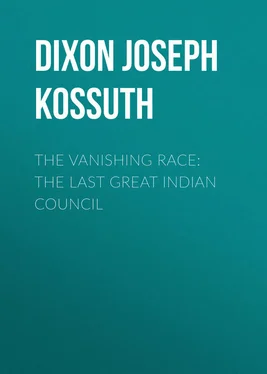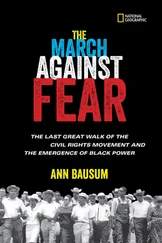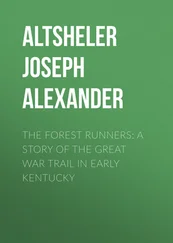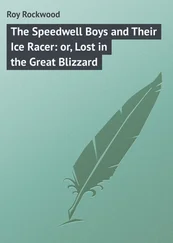Joseph Dixon - The Vanishing Race - The Last Great Indian Council
Здесь есть возможность читать онлайн «Joseph Dixon - The Vanishing Race - The Last Great Indian Council» — ознакомительный отрывок электронной книги совершенно бесплатно, а после прочтения отрывка купить полную версию. В некоторых случаях можно слушать аудио, скачать через торрент в формате fb2 и присутствует краткое содержание. Жанр: foreign_antique, foreign_prose, на английском языке. Описание произведения, (предисловие) а так же отзывы посетителей доступны на портале библиотеки ЛибКат.
- Название:The Vanishing Race: The Last Great Indian Council
- Автор:
- Жанр:
- Год:неизвестен
- ISBN:нет данных
- Рейтинг книги:5 / 5. Голосов: 1
-
Избранное:Добавить в избранное
- Отзывы:
-
Ваша оценка:
- 100
- 1
- 2
- 3
- 4
- 5
The Vanishing Race: The Last Great Indian Council: краткое содержание, описание и аннотация
Предлагаем к чтению аннотацию, описание, краткое содержание или предисловие (зависит от того, что написал сам автор книги «The Vanishing Race: The Last Great Indian Council»). Если вы не нашли необходимую информацию о книге — напишите в комментариях, мы постараемся отыскать её.
The Vanishing Race: The Last Great Indian Council — читать онлайн ознакомительный отрывок
Ниже представлен текст книги, разбитый по страницам. Система сохранения места последней прочитанной страницы, позволяет с удобством читать онлайн бесплатно книгу «The Vanishing Race: The Last Great Indian Council», без необходимости каждый раз заново искать на чём Вы остановились. Поставьте закладку, и сможете в любой момент перейти на страницу, на которой закончили чтение.
Интервал:
Закладка:
We are led to wonder often concerning the Indian's passion for his coup stick (pronounced coo). This rod, bedecked with eagle feathers and his own colour scheme, is the Indian's badge of empire. It is the “Victoria Cross” of his deeds of valour. In battle he rushes amid his foes, touches the enemy with his coup stick – that man is his prisoner, and he has counted a coup. He slays an enemy, then rushes up and touches him with the stick, takes his scalp; another coup is counted. The credit of victory was taken for three brave deeds: killing an enemy, scalping an enemy, or being the first to strike an enemy, alive or dead; any one of these entitles a man to rank as a warrior and to recount his exploit in public; but to be the first to touch an enemy is regarded as the bravest deed of all, as it implied close approach in battle. In the last Great Indian Council and on the journey home the attention of the writer was called to the prominence given to the coup stick. They are present at all ceremonial functions and are carried on all ceremonial parades. The warrior who can strike a tepee of the enemy in a charge upon a home camp thus counted coup upon it and is entitled to reproduce its particular design in the next new tepee which he made for his own use, and to perpetuate the pattern in his family. The eagle feathers on the stick can only be placed there after the warrior has counted his coup, recounted it in public, and the deed has met with the approval of all the warriors. The eagle, the proudest and most victorious of birds, then yielded a feather, which is deftly fastened with a circle of shining beads to the stick, and the proud victor flaunts another emblem of his bravery.
The buffalo, once the king of the prairies, has been practically exterminated. Perhaps no greater grief has ever entered into the life of the Indian than this wilful waste and irreparable loss. To this hour the Indian mourns the going away of the buffalo. He cannot be reconciled. He dates every joyful and profitable event in his life to the days of the buffalo. In the assembly of chiefs at the last Great Council the buffalo was the burden of every reminiscence. These veteran chiefs studied with melancholy eyes the old buffalo trails, and in contemplation of the days of the chase they said, as they thought backward, “My heart is lonely and my spirit cries.” So much did they love the buffalo that the Indian children played hunting the buffalo. The animal furnished food and clothing, and many parts of the stalwart frame they counted as sacred. The annihilation of these vast herds aroused the darkest passions in the heart of the Indian, and many times stirred his war spirit and sent him forth to do battle against the aggressors. Within the nine years between 1874 and 1883 over eight millions of buffalo were ruthlessly slain. But the war curtain of the Indian has been rung down, and the vast area which twoscore years ago supported these vast herds of wild game is covered to-day with domestic animals and teems with agricultural life, furnishing food supplies for millions upon millions all over the civilized world.
HIS HOME LIFE
Far stretches of prairie, winding watercourses, leagues of white desert with only the clouds in the sky and the shadow of the clouds on the blistering sand, an army of buttes and crags, storm carved, forests whose primeval stillness mocks the calendar of man, the haunts of the eagle, the antelope, the deer and the buffalo – and the edge of the curtain is lifted on the land where the Indian roamed and where he made his home.
Game has been found, a semi-circle of cone-shaped tepees dot the green of the plain; a stream, tree-fringed, fresh from the mountains, flows by the camp – a camp that in earlier times was pitched upon some tableland as an outlook for the enemy, white or red. Horses are browsing near at hand or far afield; old warriors and medicine men sit in the shade and smoke the long-stemmed, red sandstone pipe, and tell of the days of yore. Gayly clad figures dart hither and yon as the women are bent upon their tasks. Great loads of wood are brought into camp on an Indian woman's back. She carries water from the river, bakes the cake, upturned against the fire, boils the coffee and then all are seated on the ground when they partake of jerked beef, coffee, bread, and berries. Hands are better than knives and forks, one cup answers for many, and the strip of dried beef is passed along that all may cut off his desired portion. A noisy, gleeful group of children play with their dolls and their dogs – dogs that are made to serve as beasts of burden and instruments of torture. At night beds are made on the ground around the interior circle of the tepee and the chill of frost is driven out by a fire in the very centre – the most perfectly ventilated structure in the world – the air passing underneath the edge of the tepee in the loop where it is tied at the bottom of the poles, then passing on out through the opening at the top, carrying with it all dust and smoke. The Indian never knew anything about tuberculosis until the white man confined him in log cabins where a score of people live in one room, the cracks and keyhole entirely filled, and where they breath each other over times without number. Within the tepee the chief has the place of honour. A rest is made with supports like an easel. A lattice-work of slender willow rods passed down the front, which is covered by a long strip of buffalo hide. Against this the chief rests. Each member of the family has his allotted place inside the lodge and he may decorate his own section according to ability or fancy. Here the warrior hangs his war-bonnet and sometimes records his achievements in the chase or on the warpath. Lying all about the circle are many highly coloured parflesche bags containing the minor details of dress or any personal possession. Many of the tepees in an Indian village are embellished with Indian paintings setting forth the heroic deeds of the warriors who abide in the lodge. The figures are often grotesque and without parallel in the realm of art. The medicine is given a conspicuous place in the lodge. No one sits or lies down on the side of the tepee where they have placed the medicine of the household, and when they pass it on entering or leaving the lodge all heads are bowed. The medicine tepee is distinct from all others. It is painted a maroon, with a moon in green surrounded by a yellow circle. The medicine of the ordinary Indian family is hung over the entrance of the doorway or suspended on a pole, and may consist of a wolf skin or a dark blanket rolled in oblong fashion containing the sacred tokens of the family. Every Indian family takes pride in the ownership of a bevy of dogs. They are rich in dogs. In our camp of about thirty tepees a reliable Indian estimated that there were over three hundred dogs. These canines have free run of the lodge, and at night they crawl in under the edge of the canvas and sleep by their Indian master. Let an intruder enter the camp during the hours of darkness and they rush out simultaneously, howling like a pack of wolves until one might think the bowels of the earth had given forth an eruption of dogs. The Indian warrior makes a companion of his dog, and he can show no greater hospitality to a guest than to kill his favourite friend and serve his visitor with dog soup. To refuse this diet is an insult most vital.
The Indian woman is master of the lodge. She carries the purse. Any money that comes into the hands of the husband is immediately handed over. The servile tasks of the camp are performed by the women. Herein we have an expression of the law of equality. The husband has to perform the exhausting and dangerous task of hunting wild game for food and the skins for clothing. He had to protect the camp against hostile attacks, and the woman felt that her task was easy in comparison. The Indian child rules the family. They are rarely, if ever, corrected. No Indian mother was ever known to strike her child. If they want anything they cry until they get it – and they know how to cry. In play they are as mirthful and boisterous as any white child. They ride mock horses, and play mud ball. The Indian boy prepares willow sticks, peels off the bark, then rolls the wet clay into balls, and, sticking the ball on the end of the twig, he throws it at a mark with great speed and accuracy. Perhaps the most popular sport among the children is what they term the stick game. Again willow rods are used without the bark, only this time they are cut short enough to be rigid, and they drive them with great velocity up an inclined board. When the stick leaves the board it speeds like an arrow far in the distance. Every Indian boy and girl owns a pony, from which they are almost inseparable, and which they ride with fearless abandon.
Читать дальшеИнтервал:
Закладка:
Похожие книги на «The Vanishing Race: The Last Great Indian Council»
Представляем Вашему вниманию похожие книги на «The Vanishing Race: The Last Great Indian Council» списком для выбора. Мы отобрали схожую по названию и смыслу литературу в надежде предоставить читателям больше вариантов отыскать новые, интересные, ещё непрочитанные произведения.
Обсуждение, отзывы о книге «The Vanishing Race: The Last Great Indian Council» и просто собственные мнения читателей. Оставьте ваши комментарии, напишите, что Вы думаете о произведении, его смысле или главных героях. Укажите что конкретно понравилось, а что нет, и почему Вы так считаете.












